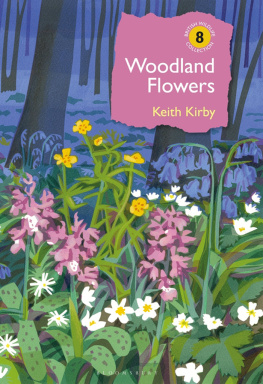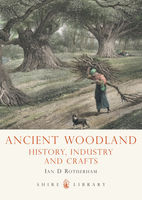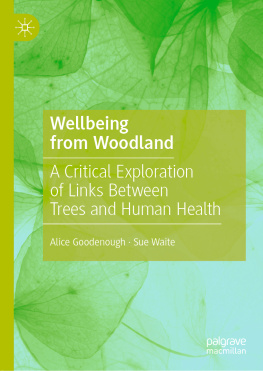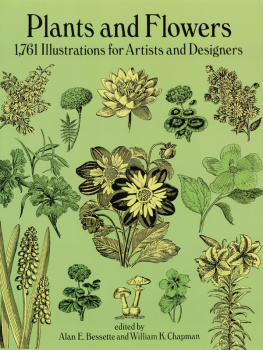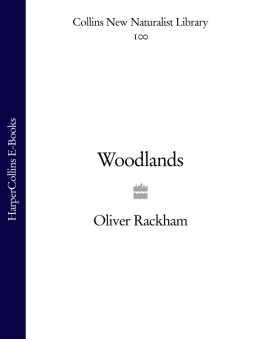

BLOOMSBURY WILDLIFE
Bloomsbury Publishing Plc
50 Bedford Square, London, WC1B 3DP, UK
This electronic edition published in 2020 by Bloomsbury Publishing Plc
BLOOMSBURY, BLOOMSBURY WILDLIFE and the Diana logo are trademarks of Bloomsbury Publishing Plc
Published with the support of the British Ecological Society

First published in the United Kingdom 2020
Copyright Keith Kirby, 2020
Keith Kirby has asserted his right under the Copyright, Designs and Patents Act, 1988, to be identified as Author of this work
For legal purposes the constitute an extension of this copyright page
All rights reserved
You may not copy, distribute, transmit, reproduce or otherwise make available this publication (or any part of it) in any form, or by any means (including without limitation electronic, digital, optical, mechanical, photocopying, printing, recording or otherwise), without the prior written permission of the publisher. Any person who does any unauthorised act in relation to this publication may be liable to criminal prosecution and civil claims for damages.
Bloomsbury Publishing Plc does not have any control over, or responsibility for, any third-party websites referred to in this book. All internet addresses given in this book were correct at the time of going to press. The author and publisher regret any inconvenience caused if addresses have changed or sites have ceased to exist, but can accept no responsibility for any such changes
A catalogue record for this book is available from the British Library
ISBN: 978-1-4729-4907-3 (HB)
ISBN: 978-1-4729-4908-0 (eBook)
ISBN: 978-1-4729-4909-7 (ePDF)
Jacket artwork by Carry Akroyd
To find out more about our authors and their books please visit www.bloomsbury.com where you will find extracts, author interviews and details of forthcoming events, and to be the first to hear about latest releases and special offers, sign up for our newsletters.
HALF-TITLE: Early-purple Orchids
FRONTISPIECE: A way through the woods
Contents

Herb- Paris; a favourite plant of mine and a fine example of botanical illustration by Rosemary Wise.
Preface
Nemophilist: one who is fond of forests or forest scenery;
a haunter of the woods .
I was born behind a pub called The Woodman, in south Essex, now just outside the M25 motorway ring, but in those days London was still some way off. It was a landscape of mixed farming, hedged fields, streams and small rivers.
The family later moved to Wheelers Yard, a black weather-board house with a garden of rough grass, an Elm clump, several small hedges and a large Crack Willow. Elder bushes grew on what had been the house rubbish dump. Every year, by an old Ash, a small patch of Lesser Celandine and Lords-and-Ladies popped up the first proper woodland flowers that I came to know.
In the nearby fields there were overgrown hedges with caves formed in the Bramble where cows found shade, and old pollard oaks with Rosebay Willowherb growing in the mould in their hollow trunks. Our primary school had a nature table with jars of flowers such as Greater Stitchwort and Cow Parsley. For some months we even had a carefully labelled badger skull, although it did look remarkably like part of a chicken skeleton! My early attempts at art were dominated by green and brown poster paint splodges labelled forest.
Those plants of woodland and hedges are an integral part of my childhood memories, and I later had a chance to study them as part of my degree in Agricultural and Forest Sciences at the University of Oxford, followed by three years of research on Bramble growth in the nearby Wytham Woods. Wytham will feature strongly in this book because it is one of the hotspots for ecological studies on a world scale, although my efforts on brambles contributed little to this great accumulation of knowledge. I did not know what sort of career might develop from an interest in nature, but through good fortune ended up with the Nature Conservancy Council (NCC), at that time the government agency concerned with wildlife conservation.
I was apprenticed to George Peterken who developed many of the ideas that still shape woodland conservation and management today. One of the perks of the job as a forestry and woodland officer was the opportunity to visit woods, to record the flowers that grew in them. This helped me and my colleagues to understand what was happening to our woods, which was essential if we were to improve their conservation.
In 2012 retirement from NCCs successor, Natural England, gave me a chance to move back to Oxford, where I am now associated with the Universitys Department of Plant Sciences. I have revived my researches in Wytham Woods and had the time to write this book a homage to the flowers in the back garden in Wheelers Yard, and to the woods, not only those of south Essex where I played as a child, but also the many others the length and breadth of Great Britain that I have had the good fortune to visit. It is also a tribute to the people who have helped and inspired me over the years.
I hope it will encourage you to look down at the wood beneath the trees, the plants of the forest floor. Woodland plants have been part of our past lives in practical ways as food and medicines, and as the inspirations for poetry, perfume and pub signs. They tell a variety of stories about the history of woodland, its past management and how that has changed over the last century or so, not always for the better. The plants can also be a very visible sign of progress when we do get it right in terms of conserving our woodland wildlife for future generations. They turn woods into magical places for me still, and bring to mind words from the traditional ballad of Thomas the Rhymer: Oh, see you not that bonny road that curves about the ferny brae. That is the path to fair elfland where you and I this night maun gae.
Acknowledgements
I am grateful to the University of Oxfords Department of Plant Sciences for the working space to produce this book; to the Nature Conservancy Council and its successors (English Nature, Natural England) who, as my employers for 33 years, allowed me to visit woods across Great Britain and occasionally abroad. Innumerable woodland owners, foresters and reserve managers shared their insights into which plants occur where and why, as well as much other useful information on woodland ecology and management.
Many people kindly provided comments on ideas and draft chapters, including Peter Buckley, Arnold Cooke, Rob Cooke, Tom Curtis, Jeremy Dagley, Nigel Fisher, Diana Gilbert, Emma Goldberg, Jeanette Hall, Ralph Harmer, Stephen Harris, Alison Hester, Della Hooke, John Hopkins, Rob Jarman, Richard Jefferson, Daniel Kelly, Jane Kirby, James Littlemore, Jim Latham, Peter Marren, Fraser Mitchell, Andy Moffat, Mike Morecroft, Suzanne Perry, George Peterken, Dominic Price, Heather Robertson, John Rodwell, Simon Smart, Tim Sparks, Jonathan Spencer, Christine Tansey, Ian Taylor, Peter Thomas, Charles Watkins, Trudy Watt, Kevin Watts and Scot Wilson. Much helpful advice came from the British Wildlife Collections editors, Katy Roper and David Campbell, who remained calm and showed tolerance throughout the writing, and to Alison Rix who copy-edited the text. I am very grateful for all their input, but any errors or misinterpretations rest with me.

